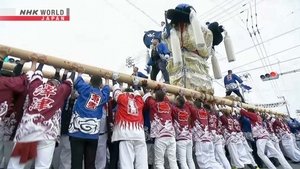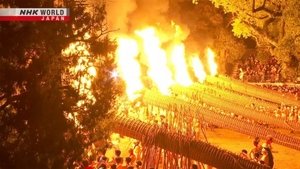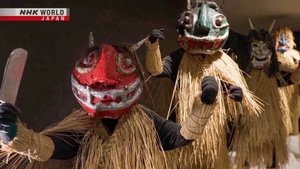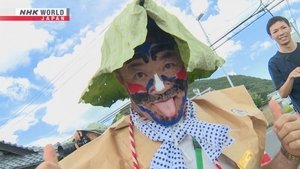
A group of men use ladles to throw water over the buildings they pass at Hibuse Matsuri, the Fire Prevention Festival in Minamisoma, Fukushima Prefecture. Temperatures are often below freezing, and bonfires help to keep everyone warm. The event conveys a prayer for the safety of residents and buildings in the coming year. It originated around 1,200 years ago, when bandits set fire to a local shrine. Legend has it that a herd of deer brought waterlogged bamboo grass to put out the flames.

Enormous floats called neputa paraded through the streets are the highlight of Hirosaki Neputa Matsuri in Hirosaki, Aomori Prefecture. The floats are decorated with vibrant images painted on washi paper. Some floats feature wireframe 3D figures. For most of the floats new art is produced every year, and preparations begin months in advance. This 300-year-old tradition began as a way to ward off drowsiness and keep people focused on farm work in the heat of summer.

Every five years there's a major kagura event in Buzen, Fukuoka Prefecture, at which the gods are entertained with performances of music and dancing. 24 well-known pieces are presented over the course of a two-day festival. In one, a figure wearing a demon mask climbs a ten-meter pole without a safety rope. Another depicts a Japanese myth about unison between heaven and earth. Children perform the same pieces, and this helps to preserve the local kagura tradition for future generations.

In Saidaiji Eyo, a matsuri in Okayama Prefecture, thousands of near-naked men endure icy water and the winter cold as they are purified at the temple. This is part of one of Japan's most prominent "naked" festivals. Usually, the men scramble to grab one of two sacred wooden items called shingi, but the event was hit hard by COVID-19. Gradually, the normal rites are being reintroduced, and this time the public can view the climax. They enjoy performances of dancing and taiko drumming, as well as a firework display.

At the Niihama Taiko Matsuri in Niihama, Ehime Prefecture, teams of around 150 people carry taikodai: three-tonne parade floats housing a huge taiko drum. In a spectacular display of strength, the bearers raise the float up above their heads. They then keep their arms straight as they turn the taikodai, and move it as impressively as they can. The display takes the form of a contest with multiple teams attempting to give the most powerful synchronized performance.

Higashinada Danjiri involves a parade of floats, decorated with images of people, plants and animals. They're pulled by teams of veterans and ridden by energetic young performers that lean out over the crowd. This is a tradition of Higashinada Ward, in Kobe, Hyogo Prefecture. In front of the ward office, the floats are lifted up, and brought down in a bowing motion. Local high school students design the costumes, and performers create a festival atmosphere with drums and bells.

Onomichi Betcha is a three-day festival in Hiroshima Prefecture. The deity of Onomichi's Ikkyu Shrine descends from a mountain, carried in a mikoshi and accompanied by three oni, or ogres. First celebrated in 1807, this matsuri began as a way to drive away an epidemic, and so the continuing impact of COVID-19 gave the event special significance in 2022. Masked figures carry sticks with which to "torment" spectators. But being hit or poked with a stick is actually said to bring good fortune.

In Kurume, Fukuoka Prefecture, the first week of the new year culminates in Oniyo: the night of the oni, or demon. Six giant torches, measuring 13 meters and weighing 1.2 tons, are moved around a shrine precinct. They create a shadow in which the oni can emerge. One torch is taken to the river, where the oni conducts a ritual that cleanses people of their troubles. This matsuri also recounts a 1,600-year-old story about a local hero defeating an outlaw—who goes on to become the oni.

On New Year's Eve, performers dress as terrifying monsters called namahage. They barge into people's homes, condemning laziness and frightening children. But this good-natured tradition strengthens family and community bonds. In Tayazawa, a small village in Akita Prefecture, the practice came to an end several years ago, but was recently restarted by an enthusiastic group of locals. They made costumes and succeeded in reviving a custom at risk of slipping away.

Inami Shishimai is a type of lion dance performed in Toyama Prefecture. Here, the shishi symbolizes the harshness and bounty of the natural world, and the matsuri focuses on the importance of harmony between people and nature. Adults play the role of the enormous shishi while a child is the shishi-tori, whose job is to pacify the shishi with sacred objects. This event is also an opportunity for local families to wish for happy marriages and children, and the shishi dances in celebration.

Etchu Owara-Kaze-no-Bon is a 300-year-old matsuri held in Yatsuo, Toyama Prefecture. Eleven neighborhoods choose their own routes, dances and parade styles, all of which feature elegant music, dancing and singing. Originally a prayer for bountiful harvests and lasting prosperity, it is a community event in which only local people dance and perform. With the threat of COVID-19 receding, the festival went ahead in 2022 for the first time in three years, to the great delight of Yatsuo residents.

The origins of Taimatsu Akashi can be traced to a battle in 1589, when the castle in Sukagawa, now a city in Fukushima Prefecture, fell to a powerful warlord. Groups of local residents form teams to construct tall torches that are carried to a local park and set alight. Taiko drums beat out a requiem for the fallen warriors. Because of COVID-19 restrictions, the matsuri in 2022 was the first version of the event since 2019. The teams put heart and soul into their elaborate structures.

Kagura, a form of votive music and dance, is a nationwide tradition with over a thousand years of history. While it is usually performed on a small stage on the grounds of a shrine, in Akitakata in Hiroshima Prefecture has a large hall dedicated to year-round kagura performances, and has 22 kagura troupes. As well as appearing on stage, they handle all the backstage and other preparations involved in putting on their strikingly memorable performances.

The Onabare festival is a 300-year-old folk cultural property in Kami, Kochi Prefecture. A portable shrine is paraded through the streets, with dancing and other performances taking place along the way. The highlight is nerikomi, which involves the careful wielding of a long, heavy pole. We see a first-timer and others battling through a tough training process, as they prepare to attempt a remarkable feat of skill and strength that is a key feature of this local matsuri tradition.

Gataine Odori is a dance that depicts what happened generations ago in Omuta, a city in Fukuoka Prefecture. In the 19th century, an embankment was constructed as a barrier against the strong tidal flows of the Ariake Sea. The areas that were reclaimed behind the embankment eventually became fertile farmland. The reclamation work involved hauling mud, and much of that work was carried out by women. Today, a group of elderly women keep that story alive by teaching it to local schoolchildren.

Kawanishi Dainenbutsu Kenbai is an elegant and dynamic dance, accompanied by flutes and taiko drums. In 2022, it was registered as UNESCO Intangible Cultural Heritage, and it even takes place at a World Heritage Site: Chusonji in Hiraizumi, Iwate Prefecture. The dance retells a story from 900 years ago, when the Buddha, in the form of a monkey, guided restless souls to the Pure Land. We meet local people who are working hard to keep the tradition alive.

Teams of local residents pour heart and soul into the construction of handmade rockets called ryusei that feature in the Yoshida Ryusei matsuri. The rockets carry local hopes and prayers high in the sky over Chichibu, Saitama Prefecture. Seventeen teams made ryusei rockets for the event in October, 2022, which was the first time the event had been held in three years. Each team has its own black powder recipe with unique ingredients and ratios to make their rocket soar.

Sawara Taisai consists of summer and autumn festivals that look back 300 years, to a time when Sawara, in Chiba Prefecture, was a vibrant cultural center. Large floats, featuring motifs such as carp and falcons, are paraded through the streets. Each belongs to a different local district, which take turns managing the festival and coordinating float movements. Every three years, a handover ceremony is held to mark the change. The festival has been certified as UNESCO Intangible Cultural Heritage.

Gojinjo Taiko is a wild, powerful performance by masked drummers. It originated 400 years ago in the small coastal community of Nafune-machi in Ishikawa Prefecture. The story goes that, faced with an imminent attack by a powerful warlord, villagers used improvised masks to disguise themselves as oni (demons), and scared away the approaching forces. Gojinjo Taiko is performed not only at the summer matsuri (festival) but at local hotels in everyday life, as a form of community revitalization.

Hyoge Festival takes place in Asano-chiku, in Kagawa-cho. This part of Japan, in Kagawa Prefecture, suffers from a lack of rainfall. The event originated as a way of giving thanks to Yanobe Heiroku, who built reservoirs in the 17th century. After he was wrongfully exiled, the locals couldn't support him openly, so they made fun, silly costumes using crops, bags and other everyday items. The story has been passed on to this day, and participants still clown around wearing handmade costumes.